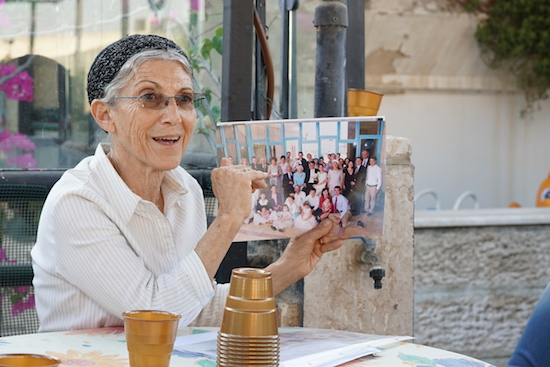‘Five Ways To Dissolve Boundaries’ photo courtesy of Gil Rouvio
Scanning through the recordings I amassed during five days in Jerusalem at Mekudeshet festival, time is compressed and borders momentarily vanish. A 4,000-year-old Samaritan prayer, performed in ancient Hebrew by Sofi Tsedaka segues into the rousing rehearsal of an Egyptian song by Arab-Muslim-Israeli singer Nasreen Qadri, which cuts to thundering electronic percussion, which drops to playful synths, both adrift in the Valley of the Cross, all interspersed with calls to prayer, church bells, house music blaring from MachneYuda, Arabic pop in an East Jerusalem bakery, birdsong, traffic, the polyphonic mishmash of an Old City shuk.
Jerusalem is all of this, but (of course) it’s also a lot more complicated. Erasure by selective documentation – curiosity-sparking sonics, choice snaps – doesn’t benefit a soul. But nor, to my mind, does boycotting an internally conflicted, multifarious nation, even one that enforces occupation. I don’t believe in punitive measures against people for the actions of their state, and I was not invited by the government.
It’s impossible to extricate the city, and Mekudeshet festival, from the weight of history and fractious politics, from socioeconomic circumstances, ethnographic demarcations and seemingly immortal conflicts. Mekudeshet, which means ‘sacred’, is run by the Jerusalem Season of Culture, an arts organisation without ties to the Israeli government, and is part funded by the philanthropic Schusterman Foundation. This seventh annual edition of the festival falls on the 50th anniversary of the Six Day War. Thankfully, Mekudeshet is staged with the explicit purpose of seeking out, amplifying and celebrating the manifold, diverse realities of Jerusalem today, rather than masking problematics.
But what impact can a cultural season truly have in this city of divine magic and untold strife? Or that’s the question I sought to answer on this trip, having visited last year, also during Mekudeshet – a stay that, while riveting and enlightening, was spent unpicking preconceptions while scrabbling for a foothold on the day-to-day actuality of Jerusalem. Ten days after returning this time, it’s still tricky to stitch arts experiences and performances, encounters with creators, makers, organisers and regular folk into a singular narrative – and it would also be arrogant. So I’ve decided to relay the most memorable moments I was privy to, which, as it happens, is loosely how the festival operates.
As artistic director, Itay Mautner says, “When you say, ‘sacred’ music, the first things that come to mind are Sunday masses, ceremonies, things like that… But for the non-religious, what [constitutes] a sacred moment? What are we willing to stand up for, and embrace wholeheartedly? [At Mekudeshet] we’re offering a series of opportunities to experience sacred moments, which, for us, is when you leave behind automatic responses, automatic feeling and thinking… Music and art can invite us into [these states].”
Beyond this immediate aim, a greater purpose unfurls – one that’s tougher to achieve and measure the success of. “We’re not putting on a festival just to put on a nice festival,” says Mautner. “I mean, it is a nice festival, but we put a lot of effort and energy into telling a bigger story from Jerusalem.” Executive director Naomi Bloch Fortis continues, “There is a different reality here – one that [diverges] from what the media, politicians and so on feed us – just no one likes to talk about it, or recognise it as a phenomena. So, we’re [not just inviting] artists who imagine beautiful moments to bring people together – what we do is always deeply connected to reality.”
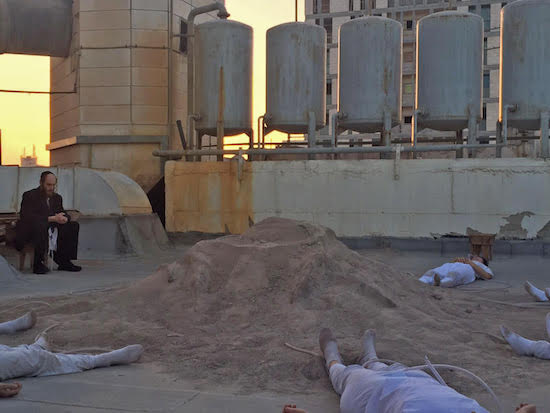
‘A Breathing Soul’ photo courtesy of Sharon Glazberg
And in reality, for attendees, this translates into a three week-long, city-wide programme – albeit one mostly focused in West Jerusalem, ostensibly for diplomacy’s sake – organised by a majority Israeli-Jewish, multi-ethnic, mixed-faith team whose rhizomatic tendrils extend far into the split city’s manifold communities. The season encompasses everything from one-off concerts such as utopian-spirited Kulna (All Of Us), featuring the East-West Jerusalem Orchestra with vocal turns by Palestinian hip hop artist Muhammad Mughrabi, to Dikla, an Israeli Arabic-language singer of Moroccan-Iraqi descent, to Armenian-Jersualemite Apo Sahagian, and Qadri, and more. All with the aim of “daring to suggest what we scarcely dare to dream of… both the most natural and the most unrealistic concept of all – a successful Middle East…”. There are daily ‘Dissolving Boundaries’ doco-theatrical bus tours to meet locals of varied ethnicities, religious affiliations and professions who, just by going about their regular lives, are gradually reshaping Jerusalem.
These ‘Dissolving Boundaries’ tours, the bedrock of the programme, are conducted in English, Hebrew and Arabic over headsets loaded with pre-recorded narration. This year’s 1000-plus tickets sold out swiftly following last year’s success. I join one, for a short while. As the tour begins we are primed to open our minds by the kindly man in the earphones, who relays his family history before discussing appearances – kippahs and other outward markers – as perceived boundaries that inspire false assumptions. He moves on to discrimination against the mentally ill in Israel. At the mention of Foucault, I dial the volume down (bad philosophy grad). It’s a worthy topic, but I want to hear the city itself.
We pull up at a social centre for people with emotional difficulties. Soon, psychiatrist Pesach Lichtenberg begins his droll, pathos-piquing presentation on setting up his ground-breaking residential talking-therapy centre for psychotic patients, having been driven to despair while working in pharmaceutical-oriented hospitals. It’s a heartening story of social enterprise, with a Hollywood-lite ending: his model is on the way to being adopted by the ‘system’.
I make my excuses and set off across town to spend the latter part of the day on Jerusalem’s rooftops – Mekudeshet has taken over a few of them for seven site-specific art installations and performances, collectively entitled ‘Above and Beyond’. The project aims to offer fresh geographical perspective and to remind people that, especially within the Old City, roofs provide extra living space for laundry, dining gathering, and sleeping. Another (discreet) motive here is to showcase rooftop potential and so cajole city officials into opening municipally owned roofs to the public.
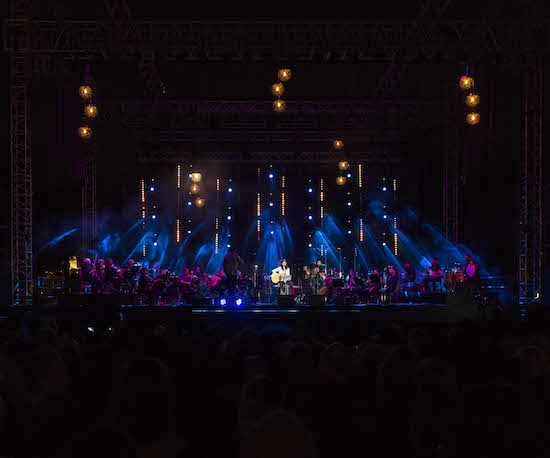
‘Kulna’ photo courtesy of Shai Dror
The previous evening, on a roof overlooking the Old City, we (a gaggle of press) experience ‘Black Couscous’ by Tunisian-Israeli mixed-media artist Rafram Chaddad, whose practice focuses on small gestures, quotidian actions, often involving food. Hands ceremonially washed, we pick our way through a diminutive barley field, specially grown over two months, to sit in a circle with Chaddad. “It’s a continuous work about the concept of black and white,” he says. “It [was inspired by] something my mother told me: her father didn’t eat black couscous when he was a kid. He preferred to eat white couscous as it looked cleaner, superior, which is how we see white in culture. And many people in Tunisia and Egypt have health problems because of processed wheat and barley… It’s [also] about subsidised flour all over the world, which tends to be the cheapest most processed kind, so the people who consume it can’t afford medical cover when they get diabetes and heart problems.” During his Mekudeshet run, this wry, erudite man invites five people up for fifteen minutes at a time, and they chat while he prepares a snack of roof-dried tomatoes, raisins and figs, and black couscous wrapped in lettuce.
The following day, the Old City’s pull is visceral. I swing by the exceptional Al Ma’amal Foundation for Contemporary Art, then get merrily lost in the warren of streets, shuks and alleyways, before stepping up to the Galazia roofs, at the juncture of the Muslim, Jewish, Armenian and Christian Quarters. Here, each night at sunset, artist Gili Avissar’s ceremony takes place, with the carrying and planting of 100 colourful flags which seem to come from different nations of cultures but have actually been invented for the ceremony. It’s undeniably pretty, and intended as a “call for change”, but my eye is repeatedly drawn to the Arab kids practising parkour on the adjacent roof. I depart for another installation atop the Clal Centre, a gargantuan 1970s shopping mall near the Mahane Yehuda market.
As I step out of the elevator, my breath catches at the sight of ‘A Breathing Soul’, by Israeli artist Sharon Glazberg. The performance piece is deeply symbolic on a host of levels. It centres on a mound of earth from beneath the Temple Mount or Haram al-Sharif (the Noble Sanctuary), perhaps the world’s holiest site, venerated by the three monotheistic religions and fought over for millennia. Above the Western Wall, its compound is home to Al-Aqsa mosque and the Dome of the Rock, and it sits atop the ruins of the First and Second Temples of the Jews. Its ashy earth was purportedly used to form Adam, as well as being the location of Abraham’s near-murder of Isaac, and Muhammad’s rise to Divine Presence.
(Breathe.)
To shorthand a nigh-on eternal story, although excavation is implausible due to the area’s immense sensitivity – regardless of its epic anthropological significance – some of this revered soil made its way out when the Waqf (the Muslim authority in charge of the zone) built an Israeli-government sanctioned emergency exit (in reportedly shoddy fashion). It is now being sifted by volunteers at Mount Scopus, and they have uncovered relics whose very existence is also contested. So let’s just say it’s about the most charged dirt on the planet. And, for seven days, a pile of it is lying on the roof of this 1970s mall with seven performers ‘guarding’ it, before ‘breathing’ life into it via ventilation tubes – until it sucks the life out of them and they drop down fake-dead.
(Breathe.)
The piece literally elevates sacred soil and allows people to visit it, which for religious folk is a golden opportunity, but it is also a ritual of remembrance for Glazberg’s grandmother, whose last ventilator-assisted moments she bore witness to. The players move through seven positions, each loaded, including the warrior stance, arrest and anguished prayer – a communal shiva.
(Breathe.)
It is a phenomenally arresting piece, what with the hypnotic sound of a ventilator broadcast into the Jerusalem gloaming, slowing one’s breathing into an artificial, but meditative, rhythm, and the cityscape, including Temple Mount and Al-Aqsa, in the background. I come back the next evening to talk to Glazberg.
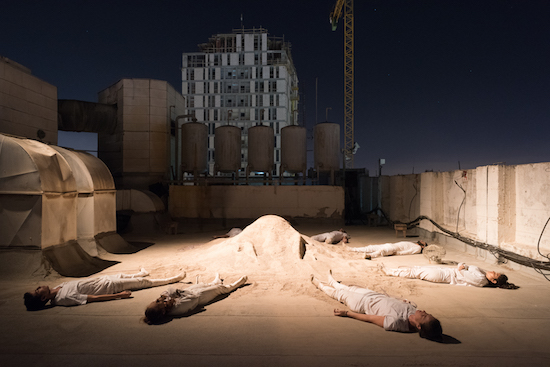
‘A Breathing Soul’ photo courtesy of Youval Hai
“You can take the most political subject and the most personal and mix them into one work, and that’s what I try to do,” she says. “On one hand, [it’s] symbolic of taking the thing that you scrape under the rug, that you don’t want to see or talk about, and putting it on the roof. On the other, I tried to [create] an intimate work. News is the least personal thing right? What you hear about Al-Aqsa, all the fighting, the big mess a few weeks ago… but then you come here, and get a personal moment with this ash, I hope it changes people’s perspectives.”
What’s proved most impactful for Glazberg has been the rolling shift in the show’s significance as the audience changes. “If a Hassidic person stands in front of it, it looks different. If a soldier comes to see it, it looks different. If a Muslim person [is here] it looks different. So the person standing in front of the work alters it… Last night a musician who came four days ago returned with her flute and played for the last hour… [And as] she started playing, suddenly, everything changed. It became very soft… It was so beautiful. I think [the piece] is a mirror in a way.”
(Breathe.)
As well as installations, and concerts, Mekudeshet also stages four rituals, collectively entitled ‘Rites of Here and Now’. Each is envisaged by a separate team from the worlds of culture, science and sport, working to create “something that in the Jewish world is called ‘kavanah’, when everybody in the same space enters the same mindset,” says Michal Vaknin, the Rites’ artistic director. “When it works, there is some kind of transformation. It sounds big, but you can create a sacred moment, after which you return to yourself a little shaken, or different.”
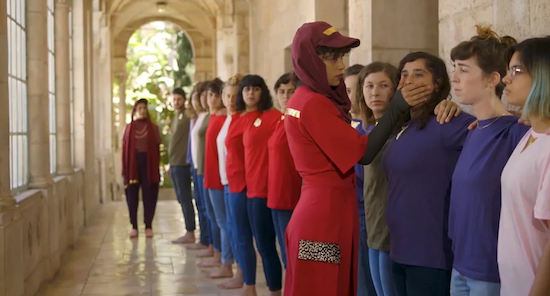
‘Basic Assumption’ screengrab
And so, this year, attendees can participate in a series of running rituals: ‘Basic Assumption’, a scientifically controlled research experiment on empathy; a mass slumber party to a specially composed soundtrack replete with nocturnal optics; and a reimagining of an ancient Jerusalem ceremony about things lost and found. As with the rest of programme, the rituals are idealistically ambitious, meticulously planned, aesthetically appealing, and in the case of one-off’s ‘Basic Assumption’ and ‘Found’, reaped profound results. But, sadly, especially in the case of the latter duo, they didn’t take place when I was in town, and so I’ll leave the theoretics out – to be honest, I imagine by this point you may have had enough.
(Breathe.)
The following night, ‘Echoes’: a group, lined up in pairs, descends into the Valley of the Cross and enters a tunnel lit by filament bulbs. Two string players face each other, sending spirals of dissonance into the night. Bathed in noise – no reasoning, pure feeling – bliss. I move through the tunnel, following soft lights underfoot till my ears catch a sound to hunt down. Scrabble over rocks. Find frenetic digital percussion, live. Meander further, find the bar. Young people laze on throws, chatting over the synths emanating from God knows where. Others stroll through, stalking sonics. It feels like a festival (chill), and also like an ancient ritual (ethereal). But. Cannot keep still. So, up, up, up, till the city lights appear at the Valley’s periphery.
(Breathe.)
Above, the moon glows – beatific, even with the ghostly music. Looking skywards, my mind reverses to a conversation with the Jerusalem Foundation’s Arielle Bernstein. She happened to be at the adjacent table in the conservatory of the plush, just-opened Villa Brown as I indulged in a long, just about perfect Israeli breakfast with a friend in from Tel Aviv. We got talking, and she mentioned that on the first night of Eid Al-Adha, not long before Rosh Hashannah, Jew Efraim Levy and Muslim Tamer Said were to lead a dual-faith prayer walk through the Old City. It was happening now – a warm thought, peace-making. Time to go.
As the sun rises the next day, having whispered adieu to the sublime Jerusalem light, I hop on a bus to Jaffa, the Arabic port south of Tel Aviv, for the weekend. I am sorry to leave, while also itching to hit airplane mode, quit documenting, bathe in tranquility.
(Breathe.)
A friendly musician, Tzlil, welcomes me into my airbnb, which, turns out, is also a cultural hub: Yafo Creative. Call to prayer drifts in through the Ottoman-style terrace doors. It’s Eid. It’s almost Shabbat. Tel Aviv’s streets quieten.
(Breathe.)
A day later, dusk descending, humidity-trance receding, I sip Israeli wine outside Beit Kandinof (an art gallery, tattoo parlour, bar and restaurant: oh so Tel Aviv), and think about how I didn’t find Jerusalem as intense this time – until now. But this trip was also more enriching: the inevitable flipside. And it’s not just due to the festival – which, on review, is generating incremental real life change through the hope they emit, their intent. It’s also the place, the millions of stories played out on Jerusalem stone and its living, breathing people. It’s bus rides in and out of Ramallah, through checkpoints, some faff with documentation – privileged white woman gets taster of dehumanising grind inflicted on those existing under occupation, yep. Roaming jammed markets (“Welcome! Welcome!”) and vertiginous streets, with (almost) zero plan. And doing the same, where I could snatch time, in Jerusalem, East and West. Everywhere I was met with friendliness. Despite the abundant public and private acrimony – a burden shared by all, just in varying weights – there is such openness, desire to engage, human to human.
(Breathe.)
In London, a week later, Tzlil WhatsApps me her new video, kaleidoscopic Middle Eastern pop with costumes that she reckons will invite an online shitstorm. I find it vaguely funny that I can’t even get a grip on what might offend who and why. I whizz through my pics again then put the phone down. I close my eyes, breathe and smile – I can still feel the Jerusalem light.

